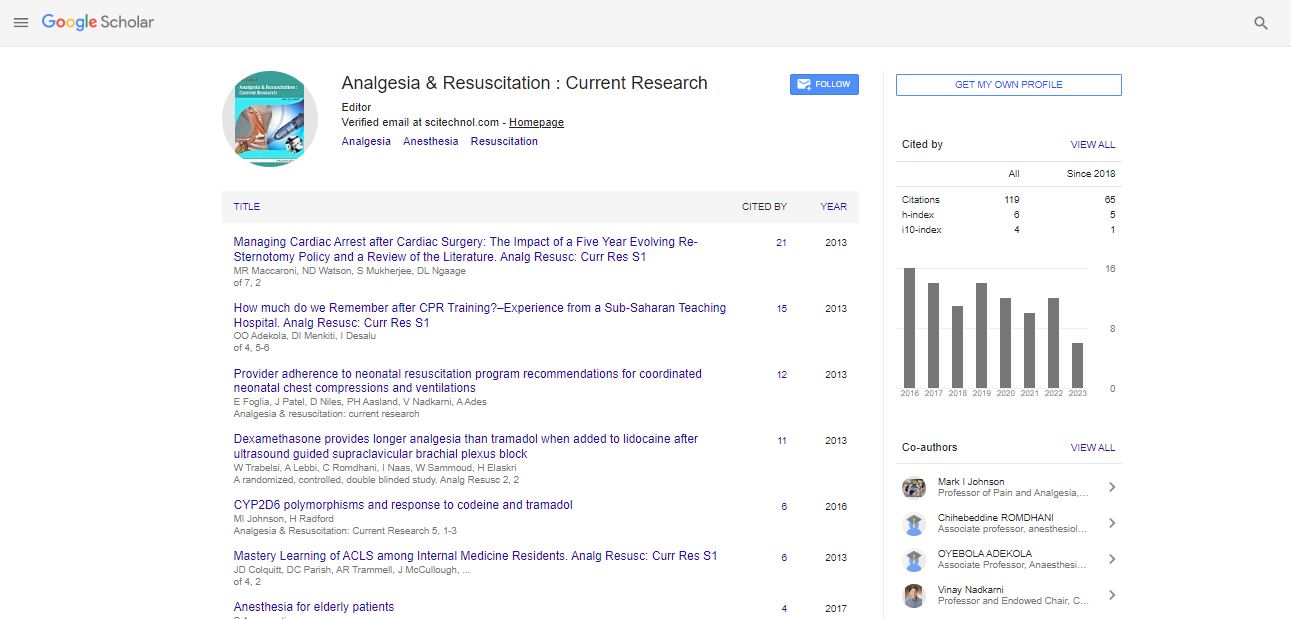Opinion Article, Analg Resusc Curr Res Vol: 12 Issue: 1
Causes and Effects of Damage in the Peripheral and Central Nervous Systems
Darlos Kelin*
1Department of Neuroscience and Experimental Therapeutics, Texas A&M Health Science Center College of Medicine, Texas, USA
*Corresponding Author: Darlos Kelin
Department of Neuroscience and
Experimental Therapeutics, Texas A&M Health Science Center College of
Medicine, Texas, USA
E-mail: darlokelin@gmail.com
Received date: 01-Feb-2023, Manuscript No. ARCR-23-93257;
Editor assigned date: 03-Feb-2023, PreQC No. ARCR-23-93257 (PQ);
Reviewed date: 17-Feb-2023, QC No. ARCR-23-93257;
Revised date: 24-Feb-2023, Manuscript No. ARCR-23-93257(R);
Published date: 03-Mar-2023, DOI: 10.4172/ 2324-903X.1000103.
Citation: Kelin D (2023) Causes and Effects of Damage in the Peripheral and Central Nervous Systems. Analg Resusc: Curr Res 12:1.
Description
The nervous system is responsible for transmitting information throughout the body and controlling various functions such as movement, sensation, and cognition. Damage or dysfunction in the nervous system can result in a wide range of symptoms and conditions, ranging from mild discomfort to severe disability or even death the causes and effects of damage or dysfunction in the peripheral and central nervous systems, as well as potential treatments and management strategies.
Peripheral nervous system
The peripheral nervous system consists of nerves that extend from the brain and spinal cord to the rest of the body. Damage or dysfunction in the peripheral nervous system can result in a variety of symptoms, including pain, weakness, numbness, and tingling. One common cause of peripheral nervous system damage is peripheral neuropathy, which can result from a variety of conditions such as diabetes, alcoholism, and chemotherapy. Peripheral neuropathy can cause symptoms such as numbness, tingling, and pain in the hands and feet, as well as muscle weakness and difficulty with coordination. Another condition that can affect the peripheral nervous system is carpal tunnel syndrome, which occurs when the median nerve in the wrist is compressed. This can cause pain, numbness, and weakness in the hand and wrist, as well as difficulty with fine motor skills.
Central nervous system
The central nervous system consists of the brain and spinal cord, which control many vital functions such as movement, sensation, and cognition. Damage or dysfunction in the central nervous system can result in a wide range of symptoms and conditions, including paralysis, seizures, and dementia. One common cause of central nervous system damage is traumatic brain injury, which can result from a variety of causes such as falls, car accidents, and sports injuries. Traumatic brain injury can cause a wide range of symptoms depending on the severity and location of the injury, including headache, dizziness, confusion, and loss of consciousness. Another condition that can affect the central nervous system is multiple sclerosis, an autoimmune disease that affects the myelin sheath that covers nerve fibers in the brain and spinal cord. Multiple sclerosis can cause symptoms such as fatigue, muscle weakness, and difficulty with coordination and balance.
Treatment and Management
Treatment and management strategies for damage or dysfunction in the peripheral and central nervous systems vary depending on the cause and severity of the condition. In some cases, surgery may be necessary to repair damage or remove tumors or other obstructions that are affecting nerve function.
In other cases, medications may be used to manage symptoms and slow the progression of the condition. For example, medications such as gabapentin and pregabalin may be used to treat peripheral neuropathy, while medications such as interferon and glatiramer acetate may be used to treat multiple sclerosis.
Physical therapy and rehabilitation can also be helpful in managing symptoms and improving function in patients with damage or dysfunction in the peripheral or central nervous systems. Physical therapy can help to improve strength, flexibility, and coordination, while occupational therapy can help patients to regain independence and improve their ability to perform activities of daily living.
Conclusion
Damage or dysfunction in the peripheral or central nervous systems can result in a wide range of symptoms and conditions, ranging from mild discomfort to severe disability or even death. While there is no cure for many of these conditions, there are a variety of treatment and management strategies that can help patients to manage symptoms and improve function. By working closely with healthcare providers and following recommended treatment plans, patients can improve their quality of life and minimize the impact of nervous system damage or dysfunction on their daily activities.

